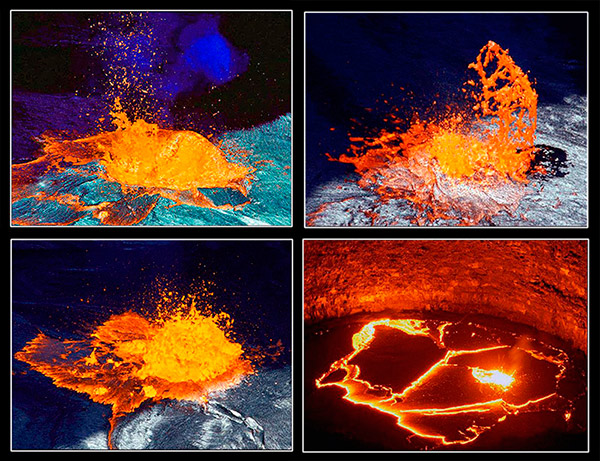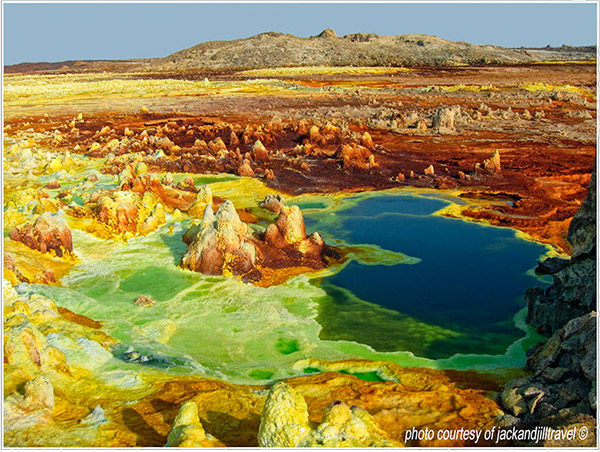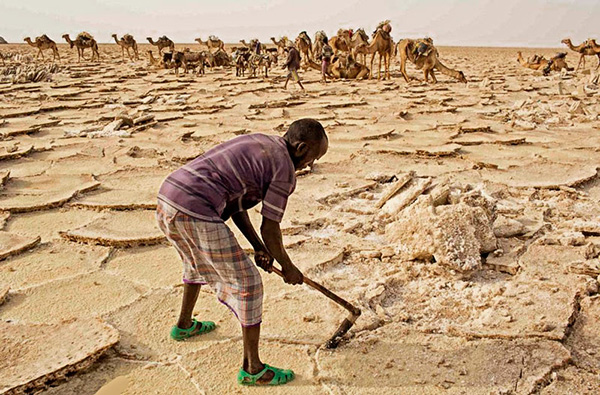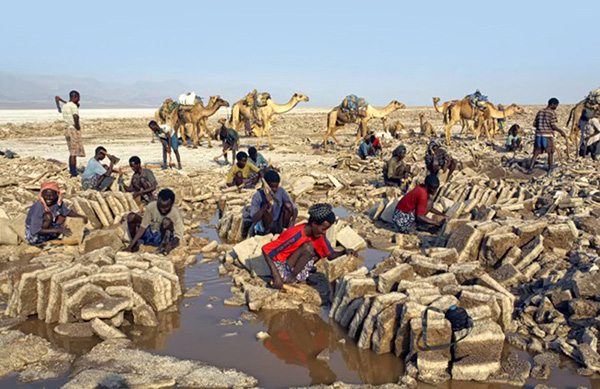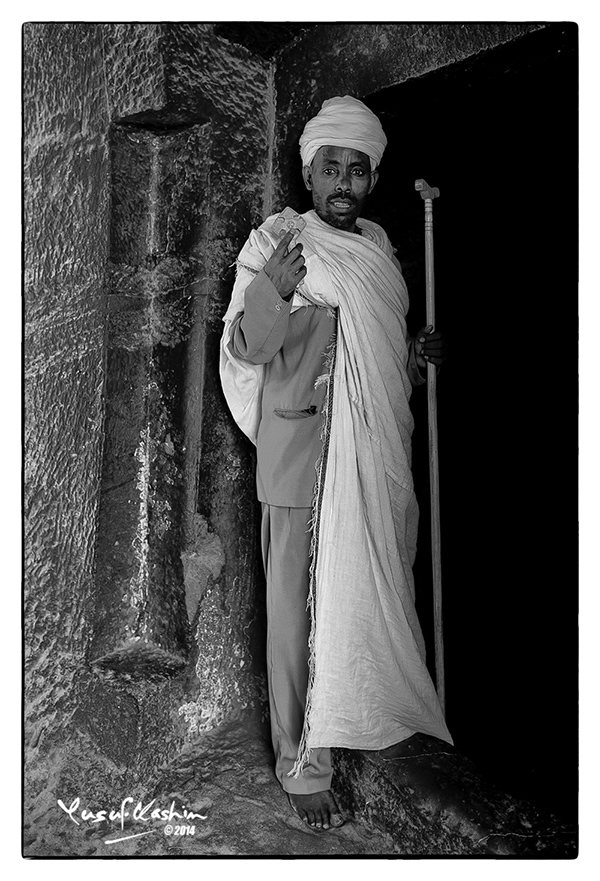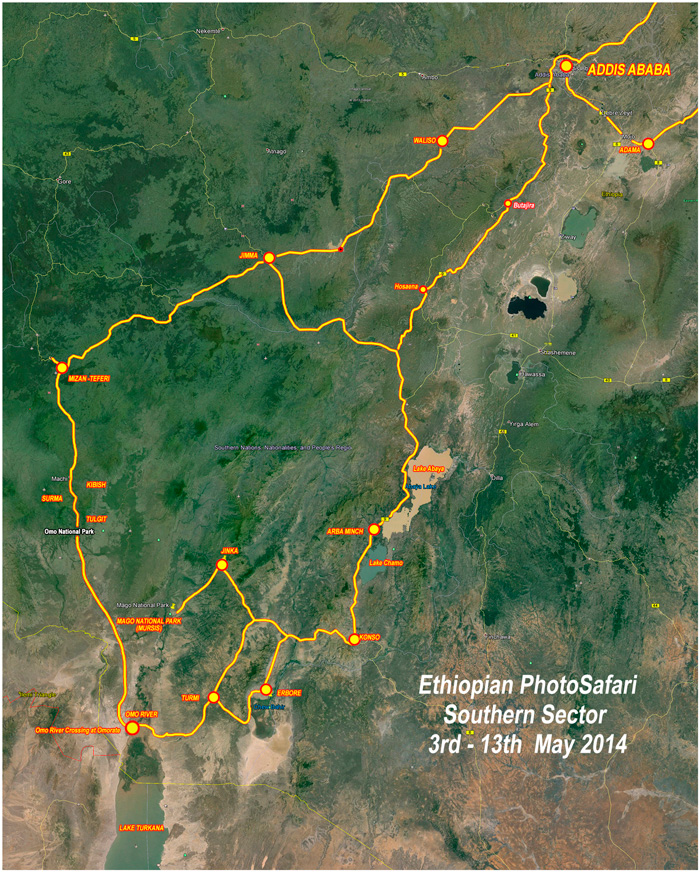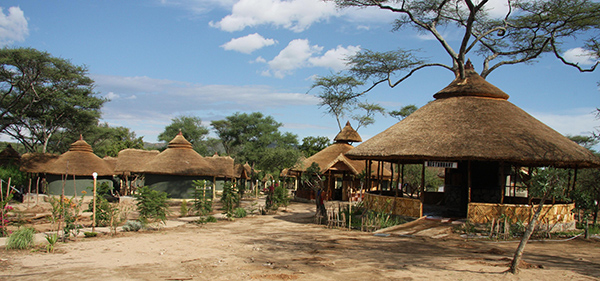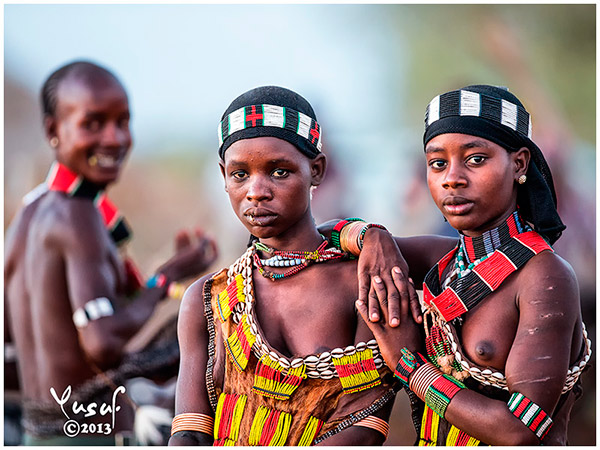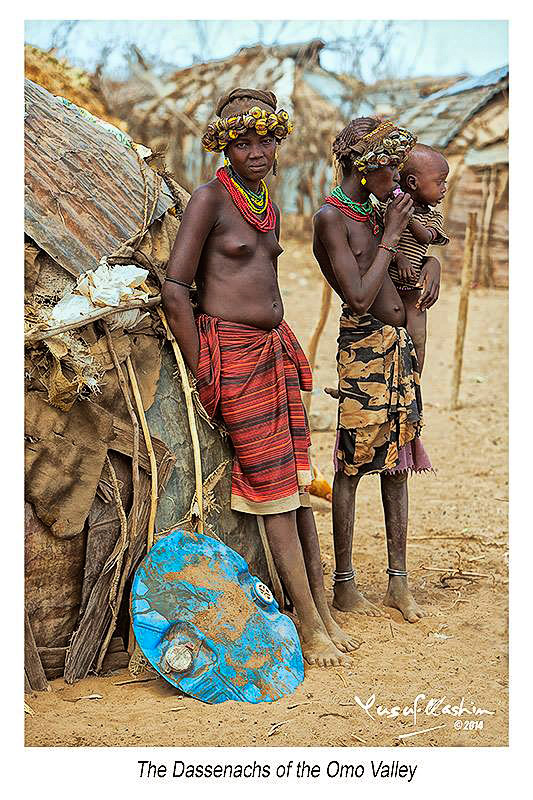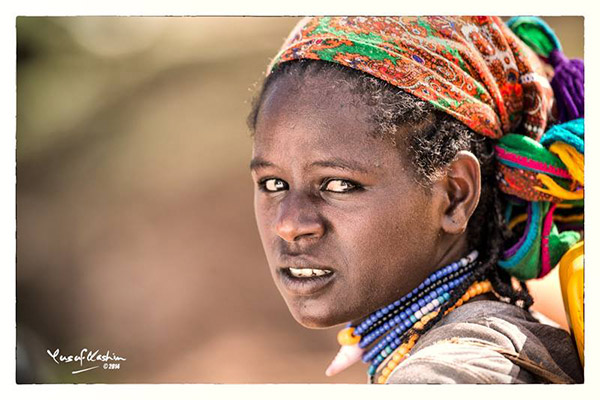PhotoSafari.com.my, this young lady from the Dassenach tribe, and this gun-toting Mursi boy from the Omo Valley, would like to invite you to join us in an exciting PhotoSafari to Ethiopia, from 24 April to 14 May, 2014.
Please book your place early by sending an email to [email protected] with your full name and email address. A US$100 early bird discount will be given to those who make firm reservations before 22nd March 2014. There are 15 places, of which 6 have already been taken up. Upon receipt of your application, we will email an information pack to you.
To cater for people with limited leave, this PhotoSafari to Ethiopia will be structured into two sectors of 10 days each. Sector One will cover the Northern Part of Ethiopia including the Danakil Depression, the Walled City of Harar, and Lalibela, while Sector Two will cover the Southern part of Ethiopia. You can participate in any one sector of your choice, but if you participate in both sectors, a substantial discount will be available. All details will be available in the information pack.
Appendix I below, is the route map & itinerary for the Northern Sector from April 24 to May 3, 2014
Appendix II is the route map & itinerary for the Southern Sector from May 3 to May 14, 2014.
For detailed information on costs or other inquiries, please call Yusuf Hashim at Telephone +6012-2712955, or email him at [email protected].
Alternatively, call Maxby Chan at +6012-2181396, or email Maxby at [email protected] .
As our departure date is just over a month away, and you’ll need to apply for visas, and we have to confirm hotel room reservations urgently, we will offer a US$100 rebate off participation costs if you confirm your participation and pay a deposit of US$1000, before 22 March, 2014. In addition, if you have been on one of our previous PhotoSafaris, you will also be entitled to a further US$100 rebate.
We have hired 5 experienced local drivers, together with 5 go-anywhere Toyota Landcruisers for this PhotoSafari. Photo below shows one of the vehicles we hired for our first Ethiopian PhotoSafari last year. We crossed this river to get to a remote village on the other side which would otherwise be inaccessible.
With these vehicles we can reach even the most remote tribal villages, where normal tourists won’t go. Each vehicle will carry only 3 participants, so everyone will have a window seat. As we have only 5 cars, we can accept a maximum of 15 participants. Six early birds have already confirmed and paid deposits to join in, so only 9 more places are available.
If you decide to come quickly, apart from an early bird rebate of US$100, you will also be able to make significant savings from early booking of flight tickets to Addis Ababa. Round trip flight tickets on Ethiopian Airlines from Kuala Lumpur to Addis Ababa and back, is presently only RM 3927. On Malaysian Airlines, the round trip tickets is RM4005. Both airlines have a code share arrangement for direct flights between Kuala Lumpur and Addis Ababa.
Below is a convenient calendar for April-May showing the dates that we will be in Ethiopia. The 20 days PhotoSafari includes 3 weekends, and one Mayday holiday, so in effect, you will need to apply for only 13 days of leave.
This PhotoSafari to Ethiopia will be structured into two sectors of 10 days each. You can participate in both sectors, or just one sector of your choice.
Sector One, from April 24 to May 3 2014, will cover the Northern parts of Ethiopia, including the Walled City of Harar, a Unesco world heritage site, where Hyena Men feed wild hyenas meat mouth to mouth, the Danakil Desert, the amazing Danakil Depression, the Mt Ertale Volcano region, the Salt Miners of the Danakil Depression, and world heritage site black Jerusalem, Lalibela, which is noted for its centuries-old churches, hewn out of solid rock. Please see Appendix I below for Route Maps and itinerary details for Sector One.
Sector Two, from May 3 to May 14, will cover Southern Ethiopia and the Omo Valley, which are the tribal lands of more than two dozen unique tribal people, who are living their lives with customs and cultures, in much the same way that their ancestors have done for hundreds of years. Please see Appendix Two below for Route Maps and itinerary details for Sector Two.
Appendix 1
Ethiopian PhotoSafari – Sector One – North Route – April 24 to May 3, 2014
Download a High Res Copy of this map from HERE
Sector One Itinerary – The North Route (April 24 to May 3 , 2014)
Note for Sector One Participants – The Northern Sector PhotoSafari starts from Bole Airport at 0800 hrs on 24 April 2014, and ends at noon checkout time on 3 of May. All expenses outside this timeblock will be for your own account. You must plan your flights such that you will be at the Arrival gate of Addis Ababa Bole International Airport by 0800 hrs on 24 April when we will commence our drive north. For Sector One participants from Kuala Lumpur, the recommended flight to Addis Ababa is Ethiopian Airlines ET619 which departs KLIA at 2325 on 23 April arriving Bole Int. Airport in Addis Ababa at 0645 on 24 April, 2014. If you are only participating in Sector One, your return flight departure should be timed for late evening of 3 May or early morning of 4 May. A suggested return flight by Ethiopian Airlines is ET618 which departs Bole at 0040 on Sunday 4 May, 2014
Day 01 – Thu 24 April, 2014, ADDIS – Awash -Harar
Arrive Bole Airport by 0800 hrs. Meet at Arrival Gate.
Emergency phones: Yusuf +6012-2712955, Maxby +6012-2181396, Daniel +251912062769. On arrival in the morning have a coffee break in Addis. Then drive down the Great Rift Valley towards the Awash National park and head for the Muslim Walled City of Harar. Overnight Harar.
Harar, commonly known as Gey and titled the City of Saints, is a walled city in eastern Ethiopia. It is a UNESCO world heritage site on a plateau with deep gorges surrounded by deserts and savannah. The walls surrounding this sacred Muslim city were built between the 13th and 16th centuries. Harar Jugol, said to be the fourth holiest city of Islam, has 82 mosques, three of which date from the 10th century, and 102 shrines, but the townhouses with their exceptional interior design constitute the most spectacular part of Harar’s cultural heritage. The impact of African and Islamic traditions on the development of the town’s building types and urban layout make for its particular character and uniqueness. A special attraction of Harar is the mouth to mouth feeding of meat to wild Hyenas by hyena men of Harar. They dont just toss pieces of meat scraps to wild hyenas, but instead they place pieces of meat on a short stick, puts the stick in their mouths, and then lets a hyena get within inches of his face in order to snatch the meat with its powerful jaws. Hyenas are the largest predators in Africa next to lions .
- Feeding Wild Hyenas Mouth to Mouth in Harar
Day 02 – Fri 25 April, 2014, Harar
Explore the Muslim walled city of Harar. See the Hyena Men feeding Hyenas mouth to mouth.
Day 03 – Sat 26 April, 2014, Harar-Awash- Semera
Drive south to Awash and then Head North East to Semera, capital of Afar state. This is a Desert town in the middle of recently solidified lava flows. We’ll get all our important papers and permits at the Semera Tourism office. Overnight at Semera Ertale Hotel
Day 4 – Sun 27 April, 2014, Semera – Ert’ale
Then we head towards Lake Afdera, which has the lowest lying island on earth that is also connected and fed by more than 300 underground sources, from the Red Sea and the entire surrounding region. It is 102 m below sea level. This the biggest source of salt in Ethiopia. We then head further North to the famous active volcano of Ert’ale “the Smoking Mountain”. Here we will meet the chief of the tribe, and he will give us camels and assign his people to carry our stuff and also we will take 4 Ethiopian soldiers to be with us in our journey to the top of the crater, walking over fresh solidified lava for about 3 hours and spend the night on the Rim of the crater. At the crater we will shoot the amazing molten lava lake in the Ertale Volcanic crater. We will wander around the Ert’ale crater by early morning light, shooting the eerie landscapes and then descend dawn to our base camp for breakfast and pack up for Amedela and Dalol – the Land of Different Colors and the Lowest Place in Africa. We’ll drive over huge salt beds and explore Dalol, spending the night in Amedela.
 The photography opportunities after dark at the molten lava lake will be awesome. Some sample photos are given below.
The photography opportunities after dark at the molten lava lake will be awesome. Some sample photos are given below.
Day 5 – Mon 28 April, 2014 Ertale -Amedela
Today we’ll see many chained camel caravans carrying salt, and we’ll drive over thick salt crusts to shoot photos of the Salt Miners, their homes and their Caravans. Life is hard here. It’s extremely hot and as water is scarce, the natives condense steam from fissures in the ground for water. Below are photos of the Afar Salt Miners who have been extracting salt here for hundreds of years.
- A Salt Miner and his Camel Caravan in the background
Day 6 – Tue 29 April, 2014 Amedela- Dalol-Lake Asale-Mekele
From Amedela we’ll drive towards the scorching hot ghost town of Dalol, which holds the world record for having the highest average annual temperatures ever recorded. From 1960 to 1966, Dalol averaged 94°F with daytime temperatures regularly rising over 100°F. There is almost never a break from the heat at any time of the year. Dallol is a ghost town today, but back in the 1960s it was a mining settlement. Its modern attractions include fascinating hydrothermal deposits like those below. The Afar Depression, where Dallol is located, is a volcanically active region, not far from Mt Dalol Volcano. So the unbearable heat here comes from every direction – from the sun above, and bubbling up from the ground below. It’ll be a fascinating region to shoot. We’ll spend the night in Mekelle, the capital of the Tigray Region and the largest city in northern Ethiopia
Day 7 – Wed 30 April, 2014, Mkele – Lalibela
Early departure from Mekelle for Lalibela, dubbed the Black Jerusalem or New Jurusalem. Lalibela is located in a mountainous region in the heart of Ethiopia near a traditional village with circular-shaped dwellings. Lalibela occupies a high place in Ethiopian Christianity, and is a destination for Christian pilgrims in Ethiopia. Its claim to fame is its more than a dozen exquisite stone churches hewn out of solid rock, hundreds of years ago. It’s a world heritage site, and the most famous of the rock churches is St Georges. It’s a fascinating place for people photography and especially of pilgrims and priests deep in payer under exquisite light in the dark stone churches. The long drive from Mekelle to Lalibela, will take us through breath taking landscapes. Overnight Lalibela at JERUSALEM HOTEL. Photo below is a priest from one of the Rock Churches in Lalibela
Day 8 – Thu 1 May, 2014, Lalibela
Today we’ll spend the whole day visiting all the stone churches, visiting the surrounding villages and shooting the thousands of pilgrims making their way to these churches. We’ll also shoot in the surrounding villages, so it’ll be a good time to search for chiaroscuro images.
Day 9 – Friday 2 May, 2014, Lalibela – Konbolcha
Today we will head to Central Ethiopia and Konbolcha and stay overnight in Konbolcha.
Day 10 – Sat 3rd May, 2014, Konbolcha – Addi Ababa
In the morning we’ll head for Addis Ababa, staying at the Monarch Hotel. Returning to Addis marks the end of Sector One. We will arrive Addis well before nightfall and you can fly out of Addis for Kuala Lumpur the same night by Ethiopian Airlines ET618 which departs Addis at 0040hr on Sun May 4th, or for Singaporeans, you can take Ethiopian Airlines ET612 departing Addis for Singapore via Bangkok also at 0040 hrs on May 4th. Hotel in Addis is paid for until noon checkout time on Sun 4th May
Flight Addis Ababa – KL. Sector One ends at 1200 hrs on Sun 4th May
Those participating in the Sector Two Southern Circuit, will stay overnight in Addis on Sat May 3nd to await arrival of those flying in to join us on Sun 4th May.
Ethiopian PhotoSafari – Sector Two
The South Route
3 to 14 May, 2014
Download a High Res Copy of this map from HERE
Sector Two Itinerary – The South Route (May 3 to May 14 , 2014)
Note for Sector Two Participants –
New Participants for Sector Two must be at the lobby of Monarch Hotel in Addis Ababa 8 am on Sunday May 4th. If you plan to arrive earlier than 4th May, we can arrange for you to stay at Monarch Hotel in Addis Ababa at your own cost, and join the participants from Sector One who will also be at the Monarch Hotel from the 3rd of May..
Recommended flights for those from Kuala Lumpur are MAS or Ethiopian Airlines ET 619, which departs KLIA Kuala Lumpur at 2325 hrs on Friday May 2nd, and ETA Addis Ababa Bole International Airport at 0645 hrs on Sat May 3rd. If you use other airlines, please ensure you are present at the lobby of Monarch Hotel by 0800 on the morning of Sat May 3rd when Sector Two officially begins. Participants from Sector One may have a leisurely breakfast at Monarch Hotel in Addis Ababa and check out by 0800 hrs on May 3rd, and wait in the lobby to be picked up when we have collected all the new arrivals from Bole Airport. Upon arrival and after Breakfast, we will head South and West for Mizan via Weliso and Jimma.
Sun 4th May, 2014, Addis Ababa – Weliso –Jimma
Please ensure you are present at Monarch Hotel Lobby by 0800 on the morning of Sun May 4th when Sector Two PhotoSafari to Ethiopia officially begins. Recommended flights are Ethiopian Airlines ET 619, ETD Kuala Lumpur 2325 on Friday May 2nd, and ETA Bole Int. Airport at 0645 hrs on Sat 3rd May. At 0800 after Breakfast on Sun 4th May, we’ll head South and West for Jimma via Weliso. The drive will be quite pleasant as traffic will be light. We will drive through an agro-friendly climatic zone, to the coffee kingdom of Keffa. We will visit the Gibe River Gorge, which is known as the Omo beyond the lower side of the gorge. Overnight at Jimma, Jimma Hotel.
Mon 5 May, Jimma-Tulgit
In Jimma, immediately after breakfast we will proceed to the local tourist office to get our permits and show our passports to travel in this region. Then we will drive through wild coffee forests – the Bebeka state coffee forest, from where the entire world’s coffee is said to have originated, and where coffee grows wild and was first discovered. From here we will then drive to the Land of Suri or The Land of Yellow Guns. As this is a remote corner of Ethiopia where there are no tourist facilities, we’ll spend the night in Surma at Tulgit Camp, or at the Missionary post. If you are squeamish, although unnecessary, it might be a good idea to bring along a cheap and light tropical sleeping bag.
Tue 6th May, Tulgit
Explore Suri Land, Villages, Cattle camps, and village markets in this very remote part of Ethiopia where not many people venture into.
Wed 7 May, Tulgit
Explore the Southern Reaches of Suri Land
Thu 8 May, Tulgit – Omo Park – Kangate –Omorate –Cross the Omo River – Turmi.
Drive down to the Omo Valley into the Omo National Park. We will visit the Erbore tribe, and their neighbours, the Hamers. We will drive through the Sacred Hamer mountains of Buska. Over night Buska Lodge in Turmi (Below)
Fri 9 May, Turmi – Karo – Turmi
This morning we drive towards the Kenyan border, near Lake Turkana, the largest permanent alkaline desert lake in Africa. We’ll take a boat to cross the Omo river to the other side and visit the Dasenech tribe who are crocodile hunters. The Dasenech live where the Omo River delta enters Lake Turkana – their name means ‘People of the Delta’. Despite the lake and delta, this is an incredibly dry region: There is nothing but desert to the west and southwest, and daytime temperatures hover round 35°C. The Daasanach are agropastoral people; they grow sorghum, maize, pumpkins and beans when the Omo river and its delta floods. Otherwise the Daasanach rely on their goats and cattle which give them milk, and are slaughtered in the dry season for meat and hides. Sorghum is cooked with water into porridge and eaten with a stew. Corn is usually roasted, and sorghum is fermented into beer. The Daasanach who herd cattle live in dome-shaped houses made from a frame of branches, covered with hides and woven boxes (which are used to carry possessions on donkeys when the Daasanach migrate). The huts have a hearth, with mats covering the floor used for sleeping.
The Dies, or lower class, are people who have lost their cattle and their way of living. They live on the shores of Lake Turkana hunting crocodiles and fishing. Although their status is low because of their lack of cattle, the Dies help the herders with crocodile meat and fish in return for meat.
Sat 10 May, Turmi – Dimeka Market- Jinka
Leave Hamer land early in the morning, and drive down to Mago National Park, crossing Mursi escarpments. Meet Mursis at their village, spending time shooting them. The Mursis are very good body art painters. Overnight Jinka Eco-Lodge. (below), located just outside Jinka and bordering the Neri River on the way to Mago National Park. The lodge has 20 Safari tent rooms with en suite bathrooms. All beds have large mosquito nets.
Sun 11 May, Jinka – Mursi-Arba Minch
Drive Jinka to Arba Minch, on the way stop at Kako Monday market. At this market we meet the Tsemay, Benna, Aris and Konsos. The Konsos are one of the biggest tribes in the Omo valley numbering 300,000. The Konso region is full of rugged land with many hills. Through time the people here have devised their own mechanism of retaining their fertile soil by developing complex and yet entirely their own, terracing systems. Extensive and intricate, this system preserves the fertility of the friable top soil and prevent them from being washed down in to the valleys below. The people are so hard working that one can hardly see an un-terraced hill. They grow sorghum, wheat, barley, maize, peas, beans, bananas, cotton, tobacco, coffee and root plants The Konso landscape is one of the 9 UNESCO world Heritage sites in Ethiopia. The natives have old walled or fortified villages. The Konso are the only remaining stone tool-using tribe, where women predominantly make and use stone tools. The Tsemays are another Cushitic group living here. They number about 15000 inhabitants. And the Bennas are Omotic tribes ancestrally native to the Omo valley, along the Omo river. Overnight at Paradise Lodge.
Mon 12 May, Arba Minch – Addis
Set off early in the morning for drive back to Addis. Experience Ethiopian folk and Cuisine at Ethiopian traditional Restaurant. Overnight Monarch Hotel in Addis Ababa
Tuesday 13 May, fly back home
Checkout time is 1200 noon on Tuesday 13th May which marks the end of the PhotoSafari. However, the recommended (best available) flight for leaving Addis is ET618 which departs Bole Airport only at 0040 hrs on 14 May, so we’ll pack our bags and store it in the hotel concierge while we explore Addis Ababa the whole of Tuesday. After dinner, we’ll pick up our luggage and go to the airport around 2100 hrs on 13 May for the flight home at 0040 am on 14 May.
The Dassenach have an amazing coming of age ceremony for young men, who jump naked over 10 bulls, as their female relatives are whipped.We will cross the Omo river and meet the Hamers at the Dimeka Saturday market.









